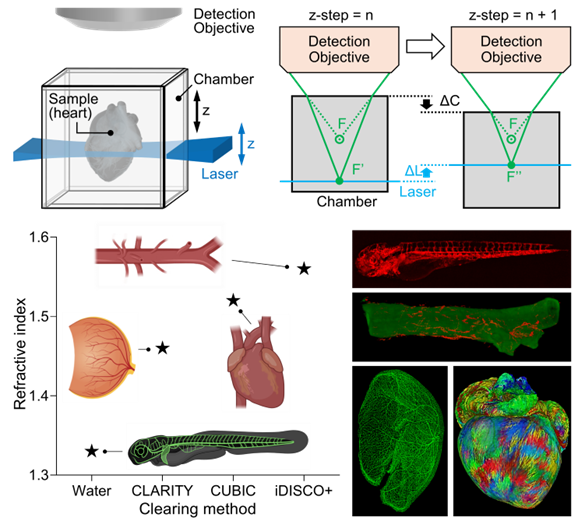Summary:
UCLA researchers from the Department of Medicine have developed a novel light-sheet fluorescence microscopy system that enables adaptive imaging across a range of refractive indices for enhanced biomedical imaging.
Background:
Light-sheet fluorescence microscopy (LSFM) has revolutionized biomedical imaging by allowing rapid and high-resolution visualization of living organisms and large tissue volumes in three dimensions. Deep tissue imaging is achieved by employing optical clearing methods that reduce light scattering through refractive index (RI) matching between the specimen being imaged and the imaging medium. Existing macro-view LSFM systems are typically optimized for a single RI that corresponds to a specific optical clearing method, limiting adaptability across different sample types. Current systems are limited by increased light refraction and aberrations that significantly lower image quality when the actual RI deviates from the value for which they were designed. While the use of adaptive optics has allowed the correction of local variations in RI values, this approach does not compensate for systematic RI mismatches across the imaging medium, restricting the use of individual LSFM systems to a narrow set of conditions. There remains an unmet need for an LSFM system that enables adaptive imaging across a wide range of refractive indices.
Innovation:
UCLA researchers from the Department of Medicine have developed a macro-view RI-corrected LSFM (rc-LSFM) system that overcomes the limitations of conventional techniques by enabling imaging across a broader range of refractive indices. This innovation greatly expands the field of view while maintaining high resolution by incorporating a novel axial sweeping mechanism that aligns the light-sheet beam with the shutter of the CCD camera. The system further integrates multi-view reconstruction, which allows capturing images from different angles to generate 3D isotropic datasets. rc-LSFM also incorporates a unique quartz imaging chamber that isolates hazardous and volatile clearing agents from exposure to the atmosphere, maintaining the system’s stability and safety. The reported technology can also adapt to different refractive indices as well as determine the RI of unknown imaging media, greatly expanding the scope of compatible optical clearing techniques. By accommodating diverse refractive indices and enhancing imaging precision, this breakthrough positions rc-LSFM as a versatile tool for high-resolution visualization of complex biological systems.

Figure: A refractive index-corrected light-sheet fluorescence microscopy system enables macro-view cardiovascular imaging across organs by adapting to refractive index variations from diverse optical clearing protocols. Examples include imaging microvascular networks, stem cell lineages, and nerve innervation, each using a distinct clearing protocol with a unique RI.
Potential Applications:
• Developmental biology imaging
• Vascular network mapping
• Cell lineage tracing
• Tumor microenvironment analysis
• 3D organ reconstruction
Advantages:
• Adaptable to multiple refractive indices
• Identifying RI of unknown imaging media
• Large field of view
• Enhanced isotropy
• Reduced image artifacts
• Improved resolution and imaging depth
Development-To-Date:
First description of complete invention: 6/2/2024
Reference:
UCLA Case No. 2025-176
Lead Inventor:
Tzung Hsiai